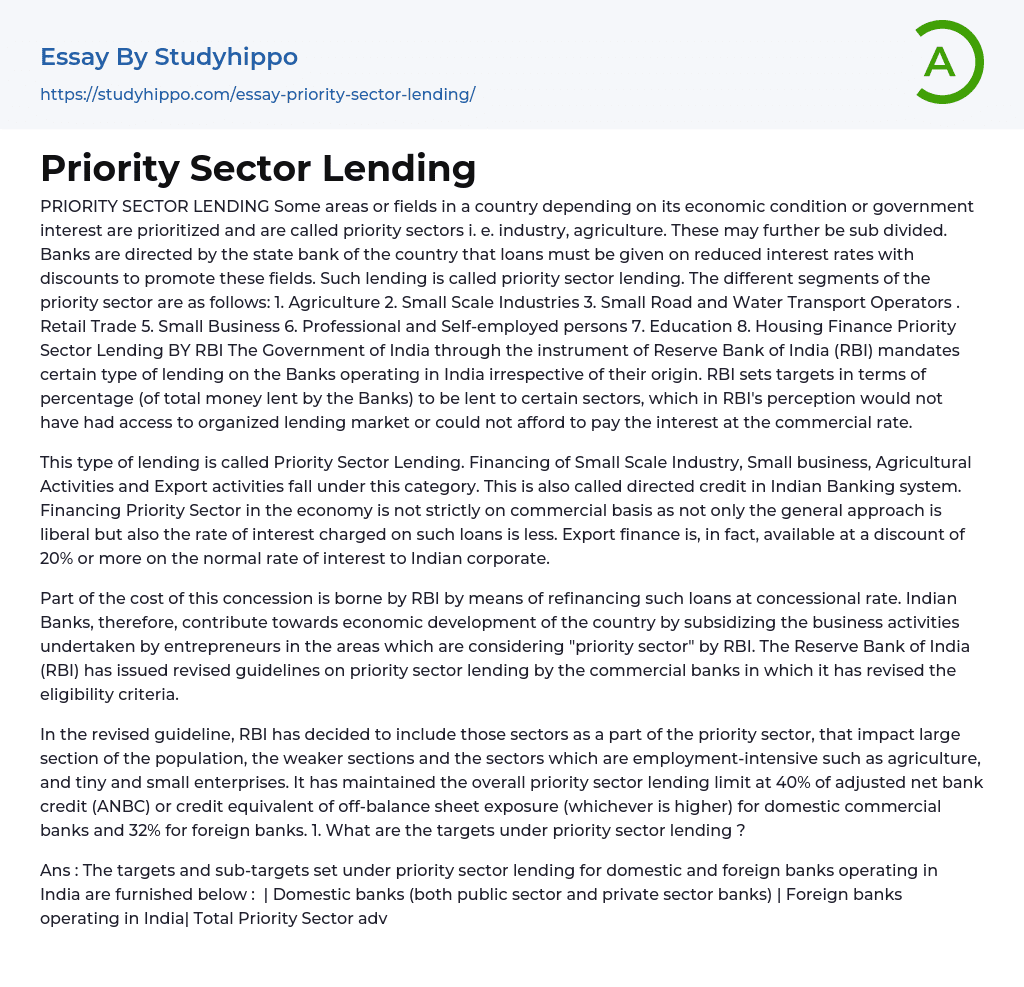Some areas or fields in a country depending on its economic condition or government interest are prioritized and are called priority sectors i. e. industry, agriculture. These may further be sub divided. Banks are directed by the state bank of the country that loans must be given on reduced interest rates with discounts to promote these fields. Such lending is called priority sector lending. The different segments of the priority sector are as follows:
- Agriculture
- Small Scale Industries
- Small Road and Water Transport Operators
- Retail Trade
- Small Business
- Professional and Self-employed persons
- Education
- Housing Finance Priority Sector Lending
The Government of India through the instrument of Reserve Bank of India (RBI) mandates certain type of lending on the Banks operating in India irrespe
...ctive of their origin. RBI sets targets in terms of percentage (of total money lent by the Banks) to be lent to certain sectors, which in RBI's perception would not have had access to organized lending market or could not afford to pay the interest at the commercial rate.
This type of lending is called Priority Sector Lending. Financing of Small Scale Industry, Small business, Agricultural Activities and Export activities fall under this category. This is also called directed credit in Indian Banking system. Financing Priority Sector in the economy is not strictly on commercial basis as not only the general approach is liberal but also the rate of interest charged on such loans is less. Export finance is, in fact, available at a discount of 20% or more on the normal rate of interest to Indian corporate.
Part of the cost of this concession is borne by RBI by means of refinancing such loans at
concessional rate. Indian Banks, therefore, contribute towards economic development of the country by subsidizing the business activities undertaken by entrepreneurs in the areas which are considering "priority sector" by RBI. The Reserve Bank of India (RBI) has issued revised guidelines on priority sector lending by the commercial banks in which it has revised the eligibility criteria.
In the revised guideline, RBI has decided to include those sectors as a part of the priority sector, that impact large section of the population, the weaker sections and the sectors which are employment-intensive such as agriculture, and tiny and small enterprises. It has maintained the overall priority sector lending limit at 40% of adjusted net bank credit (ANBC) or credit equivalent of off-balance sheet exposure (whichever is higher) for domestic commercial banks and 32% for foreign banks.
Other types of direct finance to farmers includes loans to plantations, development of allied activities such as fishery, poultry etc and also establishment of bio-gas plants, purchase of land for agricultural purposes by small and marginal farmers and loans to agri-clinics and agri-business centres. What constitutes ‘Indirect Finance’ to Agriculture? Indirect finance denotes to finance provided by banks to farmers indirectly, i. e. , through other agencies. Important items included under indirect finance to agriculture are as under :
- Credit for financing the distribution of fertilisers, pesticides, seeds, etc.
- Loans upto Rs. 25 lakhs granted for financing distribution of inputs for the allied activities such as, cattle feed, poultry feed, etc.
- Loans to Electricity Boards for reimbursing the expenditure already incurred by them for providing low tension connection from step-down point to individual farmers for energising their wells.
- Loans to State Electricity Boards
for Systems Improvement Scheme under Special Project Agriculture (SI-SPA).
Finance extended to dealers in drip irrigation/sprinkler irrigation system/agricultural machinery, subject to the following conditions:
- The dealer should be located in the rural/semi-urban areas.
- He should be dealing exclusively in such items or if dealing in other products, should be maintaining separate and distinct records in respect of such items.
- A ceiling of upto Rs. 20 lakhs per dealer should be observed.
Small scale industrial units are those engaged in the manufacture, processing or preservation of goods and whose investment in plant and machinery (original cost) does not exceed Rs. 1 crore. These would, inter alia, include units engaged in mining or quarrying, servicing and repairing of machinery. In the case of ancillary units, the investment in plant and machinery (original cost) should also not exceed Rs. 1 crore to be classified under small-scale industry.
- Bank essays
- Banking essays
- Corporate Finance essays
- Credit Card essays
- Currency essays
- Debt essays
- Donation essays
- Enron Scandal essays
- Equity essays
- Financial Accounting essays
- Financial Crisis essays
- Financial News essays
- Financial Ratios essays
- Financial Services essays
- Forecasting essays
- Foreign Exchange Market essays
- Free Market essays
- Gold essays
- Investment essays
- Legacy essays
- Loan essays
- Market Segmentation essays
- Money essays
- Personal finance essays
- Purchasing essays
- Retirement essays
- Shareholder essays
- Stock Market essays
- Supply And Demand essays
- Venture Capital essays




